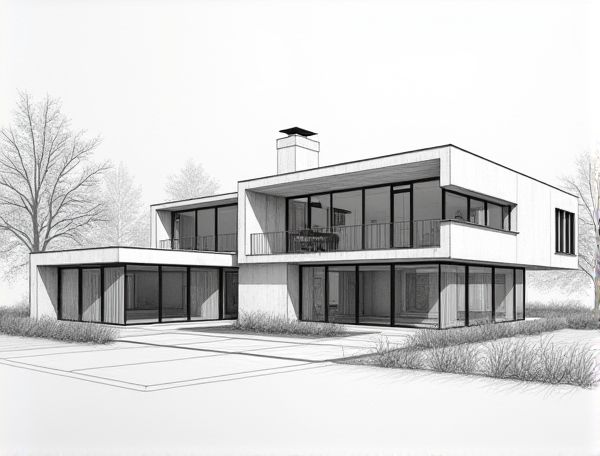
Photo illustration: Bauhaus home design with clerestory lighting
Incorporating clerestory lighting into Bauhaus home design enhances natural light flow, creating open, airy spaces that emphasize simplicity and functionality. Discover how this architectural feature can transform Your living environment by reading more in the article.
Introduction to Bauhaus Home Design
Bauhaus home design emphasizes functionality, simplicity, and the integration of modern materials like steel, glass, and concrete to create clean-lined, efficient living spaces. This architectural style originated from the Bauhaus School in Germany, promoting harmony between form and purpose while eliminating unnecessary ornamentation.
Core Principles of Bauhaus Architecture
Bauhaus architecture emphasizes the harmony of form and function, using clean lines, geometric shapes, and minimal ornamentation to create efficient and aesthetically pleasing living spaces. Your home design can benefit from the use of open floor plans, natural materials, and a seamless integration of art, craft, and technology that embody these core Bauhaus principles.
The Role of Natural Light in Modern Homes
Natural light enhances modern home design by improving indoor air quality and boosting occupant well-being through increased exposure to vitamin D. Strategic placement of large windows, skylights, and open floor plans maximizes daylight penetration, reducing energy costs and creating visually appealing, vibrant living spaces.
What is Clerestory Lighting?
Clerestory lighting refers to a design feature where high, vertically placed windows are installed near the roofline to allow natural light to penetrate deep into interior spaces. This architectural element enhances daylighting, reduces the need for artificial lighting, and creates a sense of openness by illuminating rooms from above.
Integrating Clerestory Windows in Bauhaus Homes
Clerestory windows in Bauhaus homes maximize natural light while enhancing the minimalist design and clean lines integral to the architectural style. Incorporating these high, narrow windows allows your living spaces to feel more open and connected to the outdoors without compromising privacy.
Benefits of Clerestory Lighting for Interiors
Clerestory lighting enhances interior spaces by maximizing natural light, reducing the need for artificial lighting and lowering energy costs. This elevated window placement improves ventilation and creates a sense of openness, making rooms feel brighter and more spacious. Incorporating clerestory windows in your home design brings both aesthetic appeal and functional advantages to your living environment.
Key Elements of Bauhaus Aesthetic in Lighting
Bauhaus lighting design emphasizes functional simplicity, integrating geometric shapes and clean lines to create visually striking yet practical fixtures. Materials such as steel, glass, and chrome dominate, reflecting industrial influence and durability. The use of balanced proportions and minimal ornamentation enhances spatial harmony and directs light efficiently within modern interiors.
Material Choices for Bauhaus Clerestory Design
Selecting materials for Bauhaus clerestory design emphasizes functionality and simplicity, with steel, glass, and concrete being prime choices for structural integrity and sleek aesthetics. Large glass panels maximize natural light, enhancing spatial openness and energy efficiency in your living spaces. Using raw, industrial materials aligns with the Bauhaus principle of form following function, ensuring durability and modern appeal.
Energy Efficiency and Clerestory Windows
Clerestory windows enhance your home's energy efficiency by maximizing natural light and improving ventilation, reducing reliance on artificial lighting and HVAC systems. Strategic placement of these elevated windows can significantly lower energy costs while creating a visually appealing and comfortable living space.
Tips for Designing Bauhaus Homes with Clerestory Lighting
In Bauhaus home design, clerestory lighting enhances natural illumination while maintaining clean, geometric lines that define the style. Positioning clerestory windows strategically above eye level optimizes daylight penetration and preserves privacy, making spaces feel open and airy. Incorporating energy-efficient glazing within these elevated windows supports sustainable living without compromising the minimalist aesthetic characteristic of Bauhaus architecture.
 homedesy.com
homedesy.com